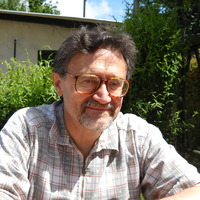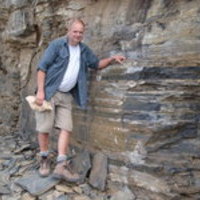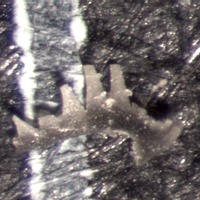
Leonid Popov
I am presently retired, yet continue my research as a honorary fellow of the Department of Natural Sciences, National Museum of Wales.
Address: National Museum of Wales, Cardiff, UK
Address: National Museum of Wales, Cardiff, UK
less
Related Authors
Lars Holmer
Uppsala University
Blanca Bauluz
University of Zaragoza
Leho Ainsaar
University of Tartu
Olle Hints
Tallinn University of Technology
Tarmo Kiipli
Tallinn University of Technology
Cole Edwards
Appalachian State University
InterestsView All (38)




Uploads
Papers by Leonid Popov
Dicranograptus hians which suggest a younger age, equating with the lowermost Ensigraptus caudatus Biozone, and the base of the Katian Stage. Most of the trilobite genera in both faunas have a wide geographical distribution in the late Ordovician, although Dulanaspis and Sinocybele are characteristic
of low latitude eastern peri-Gondwanan faunas.
benthic faunas in temperate latitude Gondwana after the Terminal Ordovician Mass Extinction.
During that time, the terranes of Kopet-Dagh and Central Iran probably formed part of the
Gondwana domain. Genera characteristic of the open shelf are mostly derived from pan-tropical
Rhuddanian faunas and contain a significant proportion of taxa which survived the Terminal
Ordovician Mass Extinction. A significant number of taxa from shallow shelf biofacies show
links to contemporaneous and older faunas of South China. Major components of the benthic
fauna including tabulate and rugose corals, brachiopods, bryozoans and ostracods, as well as
cephalopods, were new to the region and show clear links to contemporaneous low latitude
faunas (e.g. Laurentia, Baltica and South China). During the Aeronian, peri-Gondwanan terranes
of Central Iran, Kope-Dagh and Afghanistan supported shallow water faunas bearing a common
biogeographical signature, suggesting that they were positioned in relatively close proximity to
each other, and probably lay in temperate southern palaeolatitudes. Data from Iran also show
that major patterns of biofacies differentiation known for the most of the Silurian Period were
developed during the Aeronian Age.
Island on the Pacific cost of south-eastern Russia is revised, based on re-examination of the type material.
Although this species, like most described Triassic lingulids, has remained very poorly understood due to
the lack of information on important characters, such as musculature and mantle canals, it has been commonly
recorded in subsequent studies and included in attempts at understanding the patterns of extinction
and recovery at around the Permian–Triassic boundary. Linguliform brachiopods are some of the notable
survivors of this significant mass extinction event. Lingula borealis has previously been referred to Lingularia
and provisionally synonymised with Lingularia similis Biernat & Emig. Here, it is shown that it
differs from Lingularia similis mainly in characters of mantle canals, musculature and most importantly
in details of the pedicle nerve impression. In Lingularia borealis, the impression of the pedicle nerve is
symmetrical and goes almost straight between the individual ventral umbonal muscle scars, whereas in
Lingularia similis it is asymmetrically positioned towards the smaller left component of the ventral umbonal
muscle scar. Shell structures and details of preserved ontogenies have also proven to be important
for the discrimination of lingulid taxa, but cannot be provided from the types of Lingularia borealis.
Dicranograptus hians which suggest a younger age, equating with the lowermost Ensigraptus caudatus Biozone, and the base of the Katian Stage. Most of the trilobite genera in both faunas have a wide geographical distribution in the late Ordovician, although Dulanaspis and Sinocybele are characteristic
of low latitude eastern peri-Gondwanan faunas.
benthic faunas in temperate latitude Gondwana after the Terminal Ordovician Mass Extinction.
During that time, the terranes of Kopet-Dagh and Central Iran probably formed part of the
Gondwana domain. Genera characteristic of the open shelf are mostly derived from pan-tropical
Rhuddanian faunas and contain a significant proportion of taxa which survived the Terminal
Ordovician Mass Extinction. A significant number of taxa from shallow shelf biofacies show
links to contemporaneous and older faunas of South China. Major components of the benthic
fauna including tabulate and rugose corals, brachiopods, bryozoans and ostracods, as well as
cephalopods, were new to the region and show clear links to contemporaneous low latitude
faunas (e.g. Laurentia, Baltica and South China). During the Aeronian, peri-Gondwanan terranes
of Central Iran, Kope-Dagh and Afghanistan supported shallow water faunas bearing a common
biogeographical signature, suggesting that they were positioned in relatively close proximity to
each other, and probably lay in temperate southern palaeolatitudes. Data from Iran also show
that major patterns of biofacies differentiation known for the most of the Silurian Period were
developed during the Aeronian Age.
Island on the Pacific cost of south-eastern Russia is revised, based on re-examination of the type material.
Although this species, like most described Triassic lingulids, has remained very poorly understood due to
the lack of information on important characters, such as musculature and mantle canals, it has been commonly
recorded in subsequent studies and included in attempts at understanding the patterns of extinction
and recovery at around the Permian–Triassic boundary. Linguliform brachiopods are some of the notable
survivors of this significant mass extinction event. Lingula borealis has previously been referred to Lingularia
and provisionally synonymised with Lingularia similis Biernat & Emig. Here, it is shown that it
differs from Lingularia similis mainly in characters of mantle canals, musculature and most importantly
in details of the pedicle nerve impression. In Lingularia borealis, the impression of the pedicle nerve is
symmetrical and goes almost straight between the individual ventral umbonal muscle scars, whereas in
Lingularia similis it is asymmetrically positioned towards the smaller left component of the ventral umbonal
muscle scar. Shell structures and details of preserved ontogenies have also proven to be important
for the discrimination of lingulid taxa, but cannot be provided from the types of Lingularia borealis.